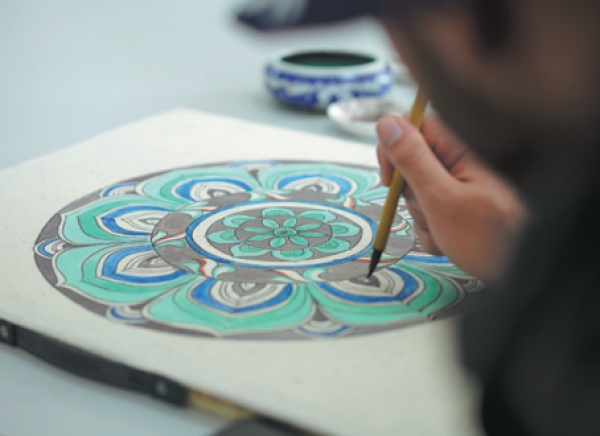Journey into culture

A student from Syria copies a pattern from the murals in the Mogao Caves at the college. [Hu Jun/For China Daily]
Santoso says he became interested in Chinese culture as a child. He even learned Chinese calligraphy for half a semester, which helped a little when he was invited to an ink painting with a Chinese artist.
All the students taking part in the cultural trip, organized by the China Public Relations Association, were invited to paint a picture together, although it was their first time drawing with ink on rice paper.
Ink painter Zhang Lucheng taught them how to do it and helped improve the painting. Zhang asked the students to carefully observe camels when riding them because camels would be the subject of the painting.
"The camel is a cultural symbol on the Silk Road. It can also be seen as a medium to spread art and culture along the route. Perceptions of camels by people across the globe are the same," explains Zhang on why he chose camels as a subject for these students, most of whom had never experienced using an ink brush before.
Zhang's style is daxieyi, an abstract ink painting that uses relaxed freehand techniques. In just several strokes, with Zhang's deft brushwork, the camel takes shape and the desert appears.
"Daxieyi demonstrates a kind of Chinese philosophy. You don't draw everything in detail, but leave a space for viewers to imagine," he says.
"The landscapes along the Silk Road are magnificent. Mountains, grasslands and desert, they are all very splendid and grand. Applying daxieyi style enables us to express that in the best possible way."
Zhang drew a camel in the center of the painting, and students added in other elements, such as the sun, the footprints of the camels, mountains, plants and houses. Finally, they were encouraged to write their names on it in their own language to jointly complete the painting.
The artist says the creation process was interesting. It's a mix of people from various cultural backgrounds, just like Dunhuang, where art from the East and the West combines with each other.
He mentions the Mogao Caves, which the students visited. The UNESCO World Heritage Site is home to hundreds of grottoes that house thousands of murals and statues and is one of the finest Buddhist art collections in China. Traces of how the art was introduced to China from the West and localized by Chinese artists can be easily found in the murals.
"Painting from Europe and Asia blends with Chinese art in Dunhuang. Chinese art started here and was spread to the world, only to return to China after being mixed with the art of other nations," adds Zhang.
-
As AI encounters Dunhuang's art, the ancient caisson ceiling bridges centuries to the present.
View all stories

 Gansu thrives from green development
Gansu thrives from green development  >
>